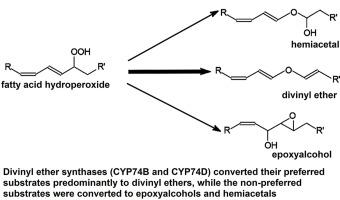当前位置:
X-MOL 学术
›
Phytochemistry
›
论文详情
Our official English website, www.x-mol.net, welcomes your feedback! (Note: you will need to create a separate account there.)
The CYP74B and CYP74D divinyl ether synthases possess a side hydroperoxide lyase and epoxyalcohol synthase activities that are enhanced by the site-directed mutagenesis
Phytochemistry ( IF 3.8 ) Pub Date : 2020-11-01 , DOI: 10.1016/j.phytochem.2020.112512 Yana Y Toporkova 1 , Elena O Smirnova 1 , Tatiana M Iljina 1 , Lucia S Mukhtarova 1 , Svetlana S Gorina 1 , Alexander N Grechkin 1
Phytochemistry ( IF 3.8 ) Pub Date : 2020-11-01 , DOI: 10.1016/j.phytochem.2020.112512 Yana Y Toporkova 1 , Elena O Smirnova 1 , Tatiana M Iljina 1 , Lucia S Mukhtarova 1 , Svetlana S Gorina 1 , Alexander N Grechkin 1
Affiliation

|
The CYP74 family of cytochromes P450 includes four enzymes of fatty acid hydroperoxide metabolism: allene oxide synthase (AOS), hydroperoxide lyase (HPL), divinyl ether synthase (DES), and epoxyalcohol synthase (EAS). The present work is concerned with catalytic specificities of three recombinant DESs, namely, the 9-DES (LeDES, CYP74D1) of tomato (Solanum lycopersicum), 9-DES (NtDES, CYP74D3) of tobacco (Nicotiana tabacum), and 13-DES (LuDES, CYP74B16) of flax (Linum usitatissimum), as well as their alterations upon the site-directed mutagenesis. Both LeDES and NtDES converted 9-hydroperoxides of linoleic and α-linolenic acids to divinyl ethers colneleic and colnelenic acids (respectively) with only minorities of HPL and EAS products. In contrast, LeDES and NtDES showed low efficiency towards the linoleate 13-hydroperoxide, affording only the low yield of epoxyalcohols. LuDES exhibited mainly the DES activity towards α-linolenate 13-hydroperoxide (preferred substrate), and HPL activity towards linoleate 13-hydroperoxide, respectively. In contrast, LuDES converted 9-hydroperoxides primarily to the epoxyalcohols. The F291V and A287G mutations within the I-helix groove region (SRS-4) of LuDES resulted in the loss of DES activity and the acquirement of the epoxyalcohol synthase activity. Thus, the studied enzymes exhibited the versatility of catalysis and its qualitative alterations upon the site-directed mutagenesis.
中文翻译:

CYP74B 和 CYP74D 二乙烯基醚合酶具有通过定点诱变增强的侧氢过氧化物裂解酶和环氧醇合酶活性
CYP74 细胞色素 P450 家族包括四种脂肪酸氢过氧化物代谢酶:丙二烯氧化合酶 (AOS)、氢过氧化物裂解酶 (HPL)、二乙烯基醚合酶 (DES) 和环氧醇合酶 (EAS)。目前的工作涉及三种重组 DES 的催化特异性,即番茄 (Solanum lycopersicum) 的 9-DES (LeDES, CYP74D1)、烟草 (Nicotiana tabacum) 的 9-DES (NtDES, CYP74D3) 和 13-DES (LuDES, CYP74B16) 亚麻 (Linum usitatissimum),以及它们对定点诱变的改变。LeDES 和 NtDES 都将亚油酸和 α-亚麻酸的 9-氢过氧化物转化为二乙烯基醚 colleneic 和 colnelenic 酸(分别),只有少数 HPL 和 EAS 产物。相比之下,LeDES 和 NtDES 对亚油酸 13-过氧化氢显示出低效率,仅提供低收率的环氧醇。LuDES分别对α-亚麻酸13-氢过氧化物(优选底物)表现出DES活性和对亚油酸13-氢过氧化物的HPL活性。相比之下,LuDES 主要将 9-氢过氧化物转化为环氧醇。LuDES 的 I 螺旋沟区域 (SRS-4) 内的 F291V 和 A287G 突变导致 DES 活性的丧失和环氧醇合酶活性的获得。因此,所研究的酶表现出催化的多功能性及其对定点诱变的定性改变。LuDES 主要将 9-氢过氧化物转化为环氧醇。LuDES 的 I 螺旋沟区域 (SRS-4) 内的 F291V 和 A287G 突变导致 DES 活性的丧失和环氧醇合酶活性的获得。因此,所研究的酶表现出催化的多功能性及其对定点诱变的定性改变。LuDES 主要将 9-氢过氧化物转化为环氧醇。LuDES 的 I 螺旋沟区域 (SRS-4) 内的 F291V 和 A287G 突变导致 DES 活性的丧失和环氧醇合酶活性的获得。因此,所研究的酶表现出催化的多功能性及其对定点诱变的定性改变。
更新日期:2020-11-01
中文翻译:

CYP74B 和 CYP74D 二乙烯基醚合酶具有通过定点诱变增强的侧氢过氧化物裂解酶和环氧醇合酶活性
CYP74 细胞色素 P450 家族包括四种脂肪酸氢过氧化物代谢酶:丙二烯氧化合酶 (AOS)、氢过氧化物裂解酶 (HPL)、二乙烯基醚合酶 (DES) 和环氧醇合酶 (EAS)。目前的工作涉及三种重组 DES 的催化特异性,即番茄 (Solanum lycopersicum) 的 9-DES (LeDES, CYP74D1)、烟草 (Nicotiana tabacum) 的 9-DES (NtDES, CYP74D3) 和 13-DES (LuDES, CYP74B16) 亚麻 (Linum usitatissimum),以及它们对定点诱变的改变。LeDES 和 NtDES 都将亚油酸和 α-亚麻酸的 9-氢过氧化物转化为二乙烯基醚 colleneic 和 colnelenic 酸(分别),只有少数 HPL 和 EAS 产物。相比之下,LeDES 和 NtDES 对亚油酸 13-过氧化氢显示出低效率,仅提供低收率的环氧醇。LuDES分别对α-亚麻酸13-氢过氧化物(优选底物)表现出DES活性和对亚油酸13-氢过氧化物的HPL活性。相比之下,LuDES 主要将 9-氢过氧化物转化为环氧醇。LuDES 的 I 螺旋沟区域 (SRS-4) 内的 F291V 和 A287G 突变导致 DES 活性的丧失和环氧醇合酶活性的获得。因此,所研究的酶表现出催化的多功能性及其对定点诱变的定性改变。LuDES 主要将 9-氢过氧化物转化为环氧醇。LuDES 的 I 螺旋沟区域 (SRS-4) 内的 F291V 和 A287G 突变导致 DES 活性的丧失和环氧醇合酶活性的获得。因此,所研究的酶表现出催化的多功能性及其对定点诱变的定性改变。LuDES 主要将 9-氢过氧化物转化为环氧醇。LuDES 的 I 螺旋沟区域 (SRS-4) 内的 F291V 和 A287G 突变导致 DES 活性的丧失和环氧醇合酶活性的获得。因此,所研究的酶表现出催化的多功能性及其对定点诱变的定性改变。



























 京公网安备 11010802027423号
京公网安备 11010802027423号